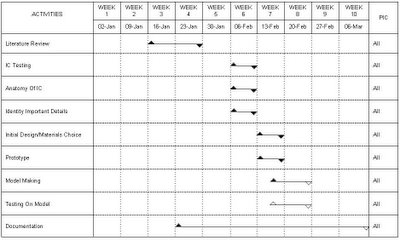IC Model Making
Introduction
The model IC is an enlarge version of the 74LS86 IC. It is enlarged 8000 times. It has a cut through transparent part located above the model and shows the interial part, magnified 8000x15 times compared to the real wafer chip.
Material selection
The model uses black cardboard as the body of the IC, aluminium sheet as the IC pins, aluminium foil as the internal wiring inside the IC and for the wafer chip components, and green paper for the base of wafer chip.
Building the Model
The model is builded by group member Lucerne. He build both the body and the interial part of the IC. The IC pins are done by me (Loh Yung Jia).

An unfinished IC model showing the interior part.










 Hollow triangulars represent proposed period.
Hollow triangulars represent proposed period.